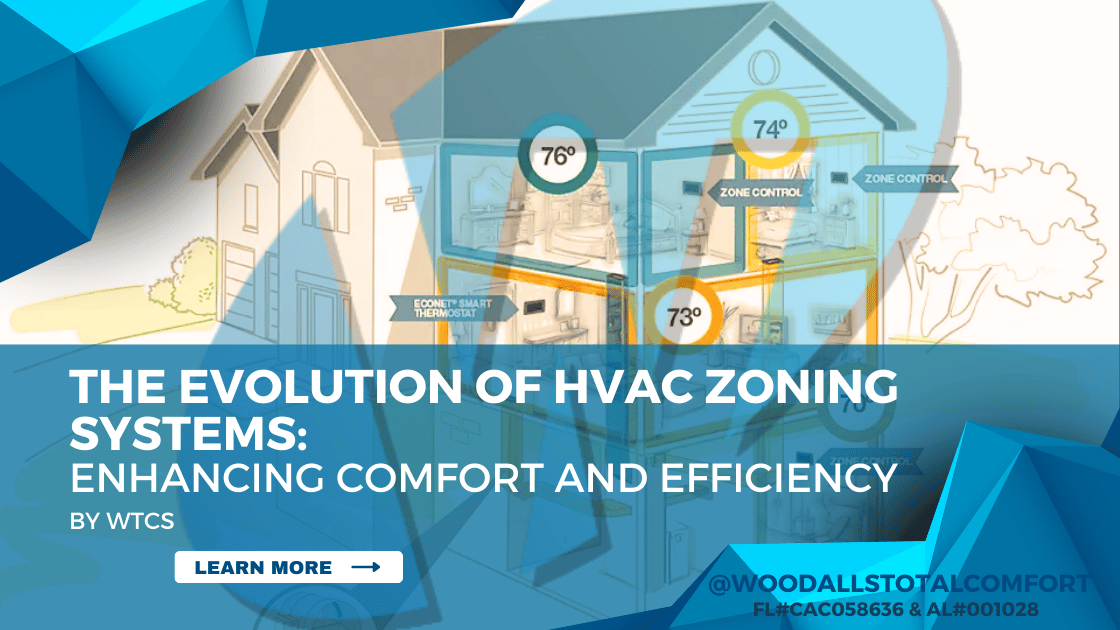The Evolution of HVAC Zoning Systems: Enhancing Comfort and Efficiency

Heating, Ventilation, and Air Conditioning (HVAC) systems have undergone significant transformations since their inception, with zoning systems emerging as a pivotal advancement. These systems have revolutionized indoor climate control, offering tailored comfort and improved energy efficiency. Let’s explore the journey of HVAC zoning systems, from their rudimentary beginnings to the sophisticated solutions available today.
Early Days: One-Size-Fits-All Approach
In the early 20th century, central heating systems became prevalent in residential and commercial buildings. These systems typically operated on a single thermostat, regulating the temperature for the entire structure. While this was a leap forward in indoor comfort, it often led to uneven temperatures, with some areas being too warm and others too cold. This lack of individualized control highlighted the need for a more nuanced approach to heating and cooling.
Introduction of Manual Zoning
As the limitations of single-zone systems became apparent, the concept of zoning emerged. Early zoning methods involved manually adjusting dampers within the ductwork to control airflow to different areas or “zones” of a building. While this allowed for some degree of customization, it was labor-intensive and lacked precision. Building occupants had to remember to adjust dampers regularly, which was neither convenient nor efficient.
Advancements in Automated Zoning
The mid-20th century saw significant technological advancements that paved the way for automated zoning systems. Motorized dampers and multiple thermostats were introduced, enabling automatic regulation of temperatures in different zones. These systems allowed occupants to set desired temperatures for specific areas, and the system would adjust airflow accordingly. This innovation not only enhanced comfort but also improved energy efficiency by directing conditioned air only where needed.
Integration with Smart Technology
In recent decades, the rise of smart technology has further transformed HVAC zoning systems. Modern systems can now be integrated with home automation platforms, allowing users to control temperatures remotely via smartphones or voice-activated assistants. Advanced sensors can detect occupancy and adjust settings in real-time, ensuring optimal comfort while minimizing energy consumption. Moreover, these systems can learn user preferences over time, adapting to routines and providing a personalized climate control experience.
Smart zoning systems also allow homeowners to track and manage their energy usage more effectively. With insights into how and when certain zones are being used, users can make informed decisions about temperature settings and daily habits, which contributes to greater energy savings and environmental responsibility.

Benefits of Modern Zoning Systems
The evolution of zoning systems has brought about numerous benefits:
- Enhanced Comfort: Different areas of a building can be maintained at varying temperatures to suit individual preferences.
- Energy Efficiency: By heating or cooling only occupied zones, energy waste is significantly reduced, leading to lower utility bills.
- Increased Equipment Lifespan: Reduced workload on HVAC systems can lead to less wear and tear, extending the lifespan of the equipment.
- Improved Air Quality: Targeted airflow can help in better managing humidity levels and reducing the spread of allergens.
- Noise Reduction: Zoning systems can reduce how frequently your HVAC system cycles on and off, making your home noticeably quieter.
Woodall’s Total Comfort Systems: Your Partner in Advanced HVAC Solutions
At Woodall’s Total Comfort Systems, we understand the importance of personalized comfort and energy efficiency in your home or business. Serving the Florida Panhandle, including Marianna, Panama City Beach, and surrounding areas, our team of experienced professionals is dedicated to providing top-notch HVAC services tailored to your specific needs.
Our comprehensive services include:
- Geothermal Systems: Harness the earth’s natural energy for efficient heating and cooling.
- AC and Heating Repair: Prompt and reliable repair services to keep your system running smoothly.
- AC Replacement: Upgrade to energy-efficient systems for enhanced comfort and savings.
- Comfort Club Maintenance Program: Regular maintenance to extend the lifespan of your HVAC system and prevent unexpected breakdowns.
We service all HVAC brands and systems, including residential and commercial units up to 25 tons. Our commitment to customer satisfaction and indoor air quality makes us the preferred choice for HVAC solutions in the region.
For more information or to schedule a consultation, call us at (850) 482-8802 or fill out our contact form online.
Licensed in Florida (FL#CAC058636) and Alabama (AL#01028). Locally serving the community since 1990.

Looking Ahead: The Future of Zoning Systems
As technology continues to advance, the future of HVAC zoning systems looks promising. Emerging trends include the integration of artificial intelligence to predict and adapt to user behaviors, further enhancing efficiency and comfort. Additionally, the incorporation of renewable energy sources and the development of more environmentally friendly refrigerants are set to make these systems even more sustainable.
Another exciting development is the integration of zoning systems with other smart home features such as automated blinds, occupancy sensors, and air purification systems. These integrations allow for complete climate control that responds to external weather changes, time of day, or even indoor air quality levels. Pushing the boundaries of what HVAC systems can offer in terms of lifestyle, health, and convenience.
To further enhance your understanding of HVAC systems and their advancements, here are some related articles from our blog:
- The Benefits of Smart Thermostats for Homeowners: Explore how integrating smart thermostats can enhance energy efficiency and provide greater control over your home’s climate.
- Why You Should Replace Your HVAC System Now: Understand the advantages of upgrading your HVAC system, including access to advanced features like programmable thermostats and zoning capabilities.
- The Evolution of HVAC Refrigerants: What to Expect in 2025 and the Big Changes Ahead: Stay informed about upcoming changes in HVAC refrigerants and how they may impact your system choices.
These articles offer valuable insights into modern HVAC technologies and can assist you in making informed decisions about your home’s comfort systems.